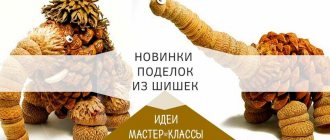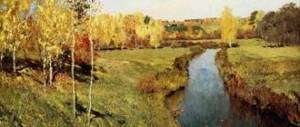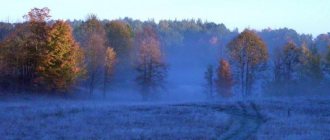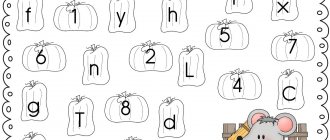Craft “Pumpkin” from old magazines
The “Pumpkin” applique can be made with children from old unwanted magazines (or advertising magazines from supermarkets).
Using the same principle, you can make an applique not only with a pumpkin, but, for example, with an apple, pear, etc. to explore Fruits and Vegetables topics with your little one. Or to study the topic “Colors” (at the same time you can watch and discuss with your child what colors are).
How to make a “Pumpkin” applique from waste material
- First, together with your child, you need to find pictures in magazines that contain the desired color (for a pumpkin we are looking for orange and a little dark green for the petiole).
- If the child knows how to cut, he cuts out pieces of the desired color from magazines; if not, an adult does this.
- Draw all the details of the applique on paper and cut out close to the outline.
- Turn them over to the reverse side (so as not to glue the outline) and glue pieces from magazines.
- Cut out the parts along the contour.
- Glue to the base - background.
For another version of an applique with a pumpkin made from cereals and seeds, see the photo at the end of the article “Crafts (appliques) from cereals with your own hands.”
Happy creativity! Only for readers of the site “MORE creative ideas for children” (https://moreidey.ru). Yulia Sherstyuk
All the best! If the site materials were useful to you, please share a link to them on social networks - you will greatly help the development of the site. Posting site materials (images and text) on other resources without the written permission of the author is prohibited and punishable by law .
Check out other interesting articles:
- Orange Halloween lamp. MK
- DIY crafts (applications) from cereals
- Craft from seeds and salt dough - painting “Flowers”
- Bag and store - collages
- Halloween crafts from thermomosaic
- Halloween garland and pendants made from tangerine peel
- Drawing on the water
- DIY puzzles for children
- Mandala - coloring book for children and adults
- Fun Easter activity: an egg with confetti inside
- DIY Matryoshka toy for kids
- Chocolate Dog - crafts made from matchboxes
Project "Miracle Pumpkin"
Study, research of objects and phenomena of the surrounding reality (natural world)
Author of the project: Kaleria Russova, 6 years old, senior group
Project manager: Tatyana Valerievna Russova, teacher of the 1st qualification category
“A child who feels like a researcher, who has mastered the art of experimentation, overcomes indecision and self-doubt. He awakens to initiative, the ability to cheerfully overcome difficulties, experience failures and achieve success, the ability to evaluate and admire the achievement of a comrade, and the willingness to help. In general, the experience of one’s own discoveries is one of the best character traits” A. Shapiro.
2. Introduction
2.1 Rationale for choosing the topic
One winter weekend, my mother brought the last pumpkin left over from the summer from the pantry. Seeing its size, I wanted to know its weight, and see what it was like inside, and generally learn more about the pumpkin.
In the meantime, my mother told me a lot of interesting things about pumpkin and its uniqueness. She reminded me of how pumpkin grows, told me what can be made and cooked from it. In general, she talked about the need and importance of pumpkin for people. And then my mother and I came up with an idea - to explore our beautiful pumpkin. This is how a project called “Miracle Pumpkin” was born.
We set ourselves a goal (hypothesis) that we would prove in different ways how important and necessary pumpkin is for people. Mom and I discussed it again and found out what we know about pumpkin. Then my mother asked me: “What else do I want to know about pumpkin?” I asked different questions, for example:
1. “What is she like?”
2. “Where and how does it grow?”
3. “What does it look like?”
4. “What do they make from it?”
5. “Where is it used?” and other questions, many of which I answered myself.
Then my mother asked, “How can we find answers to these questions?” And we decided that mom knows a lot of answers to them, the Internet will help us answer some, as well as encyclopedias, books and experiments.
Then we moved on to the practical part of our project. We began to examine the pumpkin and conduct various experiments. And we approached this problem creatively. We studied the literature, read fairy tales where pumpkin was mentioned, experimented, photographed all the experiments and, having discussed everything, moved on to the final stage of our project - summing up the results of the study. We decided to do this in the form of a presentation. And I, together with my older sister and mother, composed a short fairy tale about such a wonderful miracle pumpkin.
I think this is a relevant topic, because many people do not know how important and necessary pumpkin is in the life of a person, and other living beings. I would like, if possible, to change this using the example of my work.
Relevance: the participation of a preschool child in the “Miracle Pumpkin” project gives this child the opportunity to maximally systematize knowledge and ideas about pumpkin, its properties and applications.
Hypothesis: I suggested that pumpkin is of great importance for human life and other living beings.
Purpose of the study: development of cognitive experience and practical skills in a 6-7 year old child in research activities.
Research objectives:
To supplement and generalize the knowledge and ideas of a child of senior preschool age about the vegetable - pumpkin, its properties and uses;
Enrich your vocabulary by denoting qualities (taste, color, size, etc.);
To develop the cognitive and creative abilities of a 6-7 year old child in the process of joint research activities with a significant adult;
Develop coherent speech through composing a descriptive story about a pumpkin, composing a fairy tale; creativity, search activity;
Foster a culture of cooking (pumpkin dishes and using pumpkin); ability to set the table; table culture when tasting pumpkin dishes.
Object of study: pumpkin.
Subject of research: properties of pumpkin, use and importance of pumpkin for the life of living beings.
Research methods : conversation, observation, literature analysis and review of Internet resources, experiments.
Type of project: research - creative, individual.
By duration of the project (project type ): short-term (1-2 weeks).
Project participants: the Russov family (Kaleria - youngest daughter, 6 years old, Irina - eldest daughter, 13 years old, mother).
Expected result:
Know and name the parts of a pumpkin;
Know how the pumpkin vegetable grows, where it grows, how to care for it, its beneficial properties, harvest time, what can be prepared from it;
Compose a descriptive story about a vegetable using a schematic drawing (plan - diagram);
Be able to use pumpkins creatively (painting on skins, painting with pumpkin stamps, crafts, etc.).
2.2 Stages of work on the project
Preparatory stage
Drawing up a work plan for the project.
Conversation to identify initial knowledge and ideas about the pumpkin vegetable.
Setting the goal and objectives of the study, developing a hypothesis, determining the relevance of this study.
Selection of literature, riddles, poems, pumpkin tales, information from Internet resources.
Main stage
Consolidating, expanding and deepening knowledge about pumpkin and its capabilities.
Research and creative stage
Experiments with pumpkin; drawing on a pumpkin, pumpkin, crafts, writing a fairy tale.
The final stage
Analysis, generalization, evaluation of the results obtained in the process of joint research activities of a child and an adult.
Preparation of a project presentation in the form of a photo report on the research conducted.
Writing an abstract explaining the slides in a presentation.
Writing a fairy tale together with another school-age child and a significant adult.
3. Description of the project work and its results
3.1 Description, growth of pumpkin
Pumpkin - a golden miracle - a generous gift from nature. Pumpkin is an annual herbaceous plant of the Cucurbitaceae family with a thick, prickly, rough creeping stem up to 10 m long. The leaves are large and covered with stiff hairs. The flowers are golden yellow or orange. Pumpkins reach more than 50 cm in diameter. The peel of the fruit is hard, the pulp is fibrous, harsh, and contains a large number of flat seeds. Pumpkin seeds and pulp are eaten. Pumpkin consists of skin (17% by weight), pulp - 73% and seeds - 10% (chemical composition).
Close “relatives” of pumpkin are cucumber and squash. Pumpkin is native to Central and South America. It was grown by the American Indians. Today, pumpkin is distributed throughout the world; it is grown (in vegetable gardens and melon fields) in our country, in ancient Egypt and in China. There are several types of pumpkin: hard-boiled, butternut and giant. It grows from May to September.
3.2 Properties and uses of pumpkin
The unique properties of pumpkin have been known to people since time immemorial. It was grown more than two thousand years ago by the ancient Mexicans. Later, this vegetable enjoyed special love among the North American Indians, who considered pumpkin a gift from the sun. Usually they cut off the top of a fresh fruit and filled the inside with milk, honey and various strange seasonings, and then baked it over a fire. In addition, the Indians also used this vegetable to make dishes - the pumpkin peel was peeled from the pulp and dried in the sun. Milk, water and other products were stored in the resulting vessels.
Indians fry pumpkin slices over a fire, and from strips of dried pumpkin they make rugs that can protect their home from “evil spirits.”
Austrians are proud not so much of the beauty of pumpkin, but of the various possibilities for its processing. All that remains of the pumpkin here are the “horns and legs”, the rest goes into use: for cosmetics, medicines and black oil, which is incredibly beneficial for the liver and removes cholesterol from the body. The remaining cake is turned into all sorts of goodies on farms, such as biscuits and cookies, which you wouldn’t even think were made from pumpkin.
And there is no need to say how useful pumpkin is; it is truly a storehouse of substances necessary for human health!
Pumpkin has long been used not only for food, but also for the treatment of various diseases. Pumpkin seeds and pulp are used for treatment. The beneficial properties of pumpkin are explained by the many beneficial substances it contains.
Traditional medicine uses pumpkin pulp and seeds to treat various diseases. Pumpkin seeds are used for worms as an anthelmintic. The pulp of the plant helps normalize metabolism, treats kidney and liver diseases, and is used for weight loss. Pumpkin has a beneficial effect on our skin, healing wounds, cracks and burns. Pumpkin helps cope with insomnia very well, so at night you can drink pumpkin juice or pumpkin decoction with honey. The usefulness of pumpkin is also evidenced by the fact that its pulp is used in the production of purees for feeding children. Pumpkin, thanks to its beneficial properties, has also found its use in home cosmetics. Preparing a face mask is not difficult - just grate the pulp on a fine grater. It is recommended to apply a pumpkin mask to the face twice a week. Time - up to 20 minutes.
Forage varieties of pumpkin are used in livestock and poultry farming.
Pumpkin takes pride of place among all vegetables on our table, because you can prepare a wide variety of dishes from it - from puree to pickled pumpkin, or fried pumpkin dish. Baked pumpkin is very tasty.
There are a large number of interesting and original recipes (some of which my mother prepares for us at home).
3.3 Interesting facts about pumpkin
Since ancient times, pumpkin was called “pumpkin”.
There are more than 200 varieties of pumpkin.
Some pumpkin fruits can grow up to two hundred kg in weight and a meter in diameter, and not so long ago a pumpkin was grown in the USA whose weight was 302 kilograms, and in Pennsylvania in 1999 a record pumpkin was grown weighing 513 kilograms.
The huge spherical squash fruits, which come in yellow, orange or greenish colors, are berries.
Pumpkin comes from the same family as the cucumber.
The first mention of pumpkin was found seven thousand years ago. The ancient Indian tribes of South America were the first to grow this vegetable. The Indians consumed the pulp as food, and the peel was used to carry water, and pumpkin oil was made from the seeds.
Carotene in pumpkin is five times more than in carrots and three times more than in beef liver.
From time immemorial, pumpkin fed people and served as a material for making dishes. There is evidence that in China even wine barrels were made from pumpkin.
And amateur gardeners have developed an original way of pickling cucumbers in pumpkin fruits.
For many peoples, pumpkin is an invariable attribute of various rituals. On Halloween, a candle is placed in the hollowed-out fruit, and such a mask is considered protection against evil spirits.
The tradition of carving jack-o'-lanterns came from Ireland: the Irish carved jack-o'-lanterns for Samhain, but gradually realized that jack-o'-lanterns were better.
3.4 Experiments with pumpkin
“He who loves to work cannot sit idle”
Experiment No. 1: Measure weight
The pumpkin was very big, I couldn’t even grasp it. I couldn't even lift a whole pumpkin. I lifted half a pumpkin, but it was also very difficult. The whole pumpkin weighed 16.5 kilograms. Conclusion: we worked hard in the summer and grew a huge miracle - a pumpkin! This is an unpretentious crop that produces a large harvest.
Experience #2: Consider
Pumpkin is a large, orange berry. Pumpkin consists of peel, pulp and seeds. Its peel is dense, hard, and has a pronounced orange color. The pumpkin pulp consists of fibers that are quite strong and long (while the pumpkin is raw). If you boil the pumpkin, the fibers soften. The seeds consist of a hard white shell, a green shell (the most useful part of the seed), and a white seed. Conclusion: having carefully examined the pumpkin from the outside and inside, we learned its composition and realized that thanks to its productivity, unpretentiousness, exceptional usefulness and ability for long-term storage, it can be the “queen of vegetable gardens and tables.”
Experience #3: Sniff
When the pumpkin was cut, the aroma was unique, simply the smell of freshness, even somewhat reminiscent of watermelon. Conclusion: pumpkin is a delicious, flavorful product that can be eaten raw. Some varieties of pumpkin have a sweet taste, somewhat reminiscent of melon. To do this, you need to prepare juice from the pumpkin pulp (you can add fruit).
Experiment No. 4: Does... float?
I dropped a small piece into a jar of water and it floated. We put half the pumpkin and part of it in a bathtub filled with water for the whole day - and it also floats. Conclusion: pumpkin fruits do not sink in water and can float for a long time.
Experience #5: Try it
The taste of pumpkin is quite mild, slightly sweet, with a specific “pumpkin” aroma, a little reminiscent of the taste of potatoes, only with a sweetness, or reminiscent of the taste of unsweetened melon. Conclusion: pumpkin should take pride of place among all vegetables on our table, because you can prepare a lot of the most varied, tasty and healthy dishes from it, and everything in it is edible except the peel (which is suitable for livestock feed).
Experiment No. 6: It burns - it doesn’t burn...
I tried, with the help of my mother, to light the fiber of a raw pumpkin - nothing came of it. I dried this fiber on a radiator until crisp. It's lit and it's burning!
Conclusion: Raw pumpkin does not burn. When dried it burns very well.
Experiment #7: Freeze
I froze pumpkin in water, both in pieces and grated. It freezes very hard. Conclusion: to prepare pumpkin for the whole year, until the next harvest, you can freeze the pumpkin in the refrigerator (to save space and preserve the harvest), and then use it for cooking.
Experience #8: Cosmetic
Mom, every other day, for a week, applied a mask of grated pumpkin to her face. Conclusion: the skin of the face tightened, acquired a healthy color, and became more elastic and firm.
Experiment #9: Edible?
According to our research, pumpkin is eaten and loved by all pets. And at my house, my pet, a large African snail, Achatina, eats pumpkin. Conclusion: pumpkin is a good succulent food for living creatures.
Experiment #10: Growing pumpkin plants from seeds
I selected thick pumpkin seeds. I laid them out on a napkin on a saucer. Covered it and poured water on it. I left it to swell for 2 days in a warm place. She poured soil into the peat cells, spread out the swollen seeds and stuck them into the ground. I watered the peat cells well with soil and pumpkin seeds. Subsequent care consisted of periodic watering. The seeds sprouted on the 5th day. Conclusion: the seeds of our miracle pumpkin were “living”; they only needed water, soil, and care in order to start growing.
3.5 My creativity
“Children should live in a world of beauty, games, fairy tales, music, drawing, fantasy, creativity.” V. A. Sukhomlinsky
I am a very creative child: I love to sculpt from plasticine and dough, draw using unconventional methods, glue, cut out, make applique, do quilling, make mosaic pictures, create my own coloring books, sew clothes for dolls, and make various crafts. So when we decided to experiment with pumpkin, I was very happy. And she began to think about what she could create from a pumpkin. I came up with an idea to make a boat out of pumpkin skin. I used pumpkin stamps made by my older sister to draw patterns and ornaments. I scratched the paintings on the sandpaper with a needle. And I also love to fantasize! I write different stories and sometimes poems. And this time I composed a little fairy tale about a pumpkin.
And then, I helped my mother create miracles in the kitchen. We prepared pumpkin porridge, pureed pumpkin and potatoes, baked the pumpkin in the oven, and made pancakes. And I myself set the table beautifully and festively. And then my mother reminded me how to behave at the table - she gave me lessons on how to behave when eating and setting the table.
4. Conclusion
Pumpkin is one of the few crops that are of great importance for human life. Pumpkin is an unusually tasty and healthy product. As you can see, this cheerful sunny fruit can have a beneficial effect on your health. Many unique components and healing properties make pumpkin an indispensable product. Pumpkin on your table is the key to health, well-being and good mood.
In fairy tales, pumpkin is a good, positive hero. And probably not in vain. After all, this vegetable has a lot of useful properties and carries a large charge of positive energy. Fat Aunt Pumpkin in a Chinese folk tale and the good-natured old godfather Pumpkin from the fairy tale by Gianni Rodari... In the well-known fairy tale by Charles Perrault, the good fairy, gathering Cinderella for the ball, turned the pumpkin into a carriage. And this is no coincidence, because pumpkin is the largest of all existing vegetables (or rather, the largest berry) on Earth.
Thus, pumpkin is a source of health and beauty for people, a food product for humans and other living beings. Regular consumption of pumpkin dishes will protect you from various ailments and even restore your health. And let the beneficial properties of pumpkin help you and your health!
Conclusion: as a result of research activities (work on a project), I learned about pumpkin, its properties, and its importance for the life of living beings.
5. List of sources used
1. The Adventures of Cipollino: Based on the fairy tale by J. Rodari: For preschoolers. and ml. school age / Retelling. N.V. Khotyanovskaya; Artist B.B. Prokazov. – Mn.: Cavalier, 1996. – 192 p.: ill. – (To kids about kids).
2. Children's classics. For children from 2 to 6 years old. Reader. Compiled by E. Pozina and T. Davydova. Moscow, DRAGONZA LLC, 2009 (“Cinderella” pp. 166-184).
3. Isaeva I.S. My favorite garden. M.: World of Books, 2002. – 352 pp., ill.
4. Internet resources:
https://indasad.ru/lekarstvennye-rasteniya/3204-tikva-lechebnie-svoystva-i-protivopokazaniya-primenenie-semyan-tikvi
https://www.ayzdorov.ru/tvtravnik_tikva.php
https://mirtrav.net/travnik/tykva_obyknovennaja.html
https://clinic-virtus.com/tykva-poleznye-svojstva-i-primenenie-v-narodnoj-medicine/
https://babyfoodtips.ru/202089-tykva-dlya-detej-poleznye-svojstva-rekomendacii-po-primeneniyu-recepty/
https://pitanie-plus.com/produkty/ovoshhi/tykva.html
https://www.webfazenda.ru/pumpkin.html
https://doktorland.ru/tykva.html
https://azku.ru/skazki-narodov-azii/yunosha-tyikva.html








